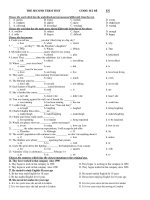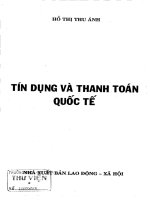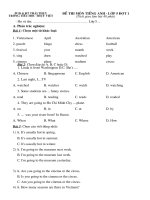thi thu anh van dong nai
Bạn đang xem bản rút gọn của tài liệu. Xem và tải ngay bản đầy đủ của tài liệu tại đây (107.29 KB, 4 trang )
THI THỬ TRUNG HỌC PHỔ THƠNG QUỐC GIA NĂM 2018
Mơn: Tiếng Anh
Thời gian làm bài: 60 phút không kể phát đề
Mark the letter A, B, C, or D on your answer sheet to indicate the word whose underlined part differs from
the other three in pronunciation in each of the following questions from 1 to 2
Question 1: A. possession
B. discussion
C. profession
D. decision
Question 2: A. needed
B. wanted
C. looked
D. decided
Mark the letter A, B, C, or D on your answer sheet to indicate the word that differs from the other three in
the position of primary stress in each of the following questions from 3 to 4
Question 3: A. museum
B. position
C. commitment
D. recommend
Question 4: A. admiration
B. enthusiast
C. discriminate
D. minority
Mark the letter A, B, C, or D on your answer sheet to indicate the correct answer to each of the following
questions from 5 to 16
Question 5: I would be rich now ________ working long ago.
A. If I gave up
B. if I wouldn’t give up C. were I to give up
D. had I not given up
Question 6: They went home after they __________ their work.
A. have finished
B. had finished
C. finished
D. would have finished
Question 7: Why don’t we stop _______ something to eat on the way home?
A. getting
B. to get
C. get
D. to have got
Question 8: The boy ______ in the accident yesterday was taken to the hospital.
A. who injured
B. be injured
C. injured
D. was injured
Question 9: They’re Mai’s books; she _________ them here.
A. must have left
B. ought to have left
C. should have left
D. might be left
Question 10:The opening of the new museum was a ______ occasion for everyone involved.
A. memory
B. memorial
C. memorable
D. memorably
Question 11: We had better _______ if we want to get there in time.
A. take up
B. turn down
C. speed up
D. put down
Question 12: His girlfriend left him last month and he still hasn’t got ____ it.
A. over
B. by
C. off
D. past
Question 13: When the Titanic started sinking, the passengers were __________.
A. horrifying
B. apprehensive
C. panic- stricken
D. weather-beaten
Question 14:No one knows much about her private life because she is quite _______.
A. shy
B. sensitive
C. sociable
D. reserved
Question 15:The house ______ Shakespeare was born is now open to the public.
A. whose
B. who
C. where
D. when
Question 16: The computer has had an enormous _______ on the way we work.
A. change
B. alteration
C. influence
D. impression
Mark the letter A, B, C, or D on your answer sheet to indicate the sentence that best completes each of the
following exchanges from 17 to 18
Question 17: : - Peter: “Can I carry these suitcases into the room for you?”
- Lucy: “_______________________”
A. You can’t. I think!
B. No, you can’t
C. Yes, you can
D. Can you? That’s very kind.
Question 18: - Hana “ I think it is a good idea to have three or four generations living under one roof.”
- Jenifer: “___________. Family members can help each other a lot.”
A. It’s not true
B. That’s wrong
C. I couldn’t agree more
D. I don’t agree
Mark the letter A, B, C, or D on your answer sheet to indicate the word(s) OPPOSITE in meaning to the
underlined word(s) in each of the following questions from 19 to 20
Question 19: The table is too heavy for me to move alone.
A. light
B. easy
C. old
D. bulky
Question 20: The new laws to conserve wildlife in the area will come into force next month.
A. eliminate
B. protect
C. pollute
D. destroy
Mark the letter A, B, C, or D on your answer sheet to indicate the word(s) CLOSEST in meaning to the
underlined word(s) in each of the following questions from 21 to 22
Question 21: The United Nationals Educational, Scientific and Cultural Organization (UNESCO) was
established in 1946.
A. set up
B. found out
C. run through
D. put away
Question 22: They are going to suffer a lot of criticism for increasing bus fare by so much.
A. get into
B. stand in with
C. come in for
D. put
Mark the letter A,B,C or D on your answer sheet to indicate the sentence that best combines each pair of
sentences in the following questions from 23 to 24
Question 23:The room is small. We do not need much furniture.
A. The smaller the room is, the less furniture we need.
B. The smaller the room is, the fewer furniture we need.
C. The small room makes the furniture less and less.
D. Much furniture is needed for a small room.
Question 24: Mary told us about her leaving the school. She did it on her arrival at the meeting.
A. Only after her leaving the school did Mary inform us of her arrival at the meeting.
B. Not until Mary told us that she would leave the school did she arrive at the meeting.
C. Hardly had Mary informed us about her leaving the school when she arrived at the meeting.
D. No sooner had Mary arrived at the meeting than she told us about her leaving the school.
Mark the letter A, B, C or D on your answer sheet to indicate the sentence that is CLOSEST in meaning to
each of the following questions from 25 to 27
Question 25: “I’m sorry, I was rude to you yesterday,” I said to Tom.
A. I apologized of having been rude to Tom the day before.
B. I apologized to Tom for having been rude to him the day before.
C. I apologized for my rude to Tom yesterday.
D. I apologized to Tom as I was rude to you the day before.
Question 26: When I picked up my book, I found that the cover had been torn.
A. Picking up my book, the cover had been torn.
B. On picking up my book, I saw that the cover had been torn.
C. Picked up, I saw that the cover of the book was torn.
D. The cover had been torn when my book picked up.
Question 27: My suit needs to be cleaned before the interview but I am too busy to do that.
A. I must get someone clean my suit before the interview.
B. I must have my suit cleaned before the interview.
C. I should have cleaned my suit before the interview.
D. I must clean my suit before the interview.
Mark the letter A,B,C or D on your answer sheet to indicate the underlined part that needs correction in
each of the following questions from 28 to 30
Question 28: Even on the most careful prepared trip, problems will sometimes develop.
A. Even
B. careful
C. develop
D. trip
Question 29: Hardly had he entered the room than all the lights went out.
A. went out
B. than
C. the lights
D. had he entered
Question 30: It is Tom that has admitted to steal my watch.
A. is
B. that
C. has admitted
D. to steal
Read the following passage and mark the letter A, B, C, or D on your answer sheet to indicate the
correct word or phrase that best fits each of the numbered blanks from 44 to 48
There has been an outbreak of avian influenza, better known as bird flu in Asia recently. The first
(31)________ died two weeks ago in Vietnam and there have been the cases reported since in Thailand, and
there are some suspected cases in Cambodia as well as.
Wild birds are affected by a large number of flu viruses, just as the humans and other animals are, but
they are normally exclusive to birds. If the viruses manage to mutate, they can to jump the species barrier and
infect human beings. The first case (32)________ someone died was in Hong Kong in 1997.
There are the several different forms of bird flu, ranging from mild to very serious infections,
which spreading rapidly and kill many of the birds they infect. It is spread by wild birds-ducks, in particular –
which carry the virus, but aren't killed by it. They can spread the virus (33)________ farm birds through direct
contact or by the contaminating water supplies.
World Health Organization officials have attributed the spread of bird flu to human contact with
the droppings of infected birds and (34)________ sanitation. There was no evidence at first that the virus
spread from person to person, (35)________ there has been a case of this happening being investigated by
scientists.
Question 31: A. victim
B. casualty
C. infector
D. sufferer
Question 32: A. when
B. which
C. why
D. where
Question 33: A. in
B. on
C. to
D. for
Question 34: A. bad
B. poor
C. awful
D. terrible
Question 35: A. since
B. so
C. but
D. though
Read the following passage and mark the letter A, B, C, or D on your answer sheet to indicate the correct
answer to each of the questions from 36 to 42
Increasing numbers of parents in the U.S. are choosing to teach their children at home. In fact, the U.S.
Department of Education has estimated that in 1999, about 850,000 children were being homeschooled. Some
educational experts say that the real number is double this estimate, and the ranks of homeschooled children
seem to be growing at the average rate of about eleven percent every year.
At one time, there was a theory accounting for homeschooling: it was traditionally used for students
who could not attend school because of behavioral or learning difficulties. Today, however, more parents are
taking on the responsibility of educating their own children at home due to their dissatisfaction with the
educational system. Many parents are unhappy about class size, as well as problems inside the classroom.
Teacher shortages and lack of funding mean that, in many schools, one teacher is responsible for thirty or forty
students. The children are, therefore, deprived of the attention they need. Escalating classroom violence has
also motivated some parents to remove their children from school.
Although there have been a lot of arguments for and against it, homeschooling in the U.S. has become
a multi-million dollar industry, and it is growing bigger and bigger. There are now plenty of websites, support
groups, and conventions that help parents protect their rights and enable them to learn more about educating
their children. Though once it was the only choice for troubled children, homeschooling today is an accepted
alternative to an educational system that many believe is failing.
Question 36: What does the passage mainly discuss?
A. The increasing of homeschooling in the U.S. and its reasons
B. Arguments for and against homeschooling in the U.S.
C. Websites support homeschooling in the U.S.
D. Causes and effects of homeschooling in the U.S.
Question 37: The number of parents who want to teach their own children in the U.S. is _____.
A. remaining unchanged
B. remaining the same
C. going up
D. going down
Question 38: The word “homeschooled” in paragraph 1 is closest in meaning to ______.
A. be taught at home
B. self-learned at home C. untaught at home
D. self-studied at home
Question 39: According to some experts, the exact number of homeschooled children in the US in the last
year of the 20th century must be _____.
A. 1,600,000
B. 850,000
C. 1,900,000
D. 1,700,000
Question 40: The noun “dissatisfaction” in paragraph 2 is closest in meaning to _____.
A. disappointment
B. disagreement
C. discrimination
D. discouragement
Question 41: The word “it” in paragraph 3 refers to ______.
A. argument
B. homeschooling
C. industry
D. website
Question 42: According to paragraph 1, which of the following is NOT true?
A. More parents in the U.S. are educating their own children at home.
B. Class size is one of the reasons of dissatisfaction of parents in the U.S.
C. In the U.S., one teacher is responsible for thirty or forty students per class.
D. Classroom violence at school is decreasing in the U.S.
Read the following passage and mark the letter A, B, C, or D on your answer sheet to indicate the correct
answer to each of the questions from 43 to 50
There is a strange paradox to the success of the Asian education model. On the one hand, class sizes
are huge by Western standards with between 30 and 40 students per class, in countries like Japan and Korea.
On the other hand, school children in developed Asian economies rank among the highest in the world for
academic achievement in the areas of science and mathematics, especially on standardised tests. Meanwhile,
British secondary school students fail to shine in conditions most educational researchers would say are far
more likely to help them succeed.
Classroom management seems to be easier in places like Korea, and perhaps lessons are more
effective as a direct consequence. After all, we are only too aware of the decline in discipline standards in our
own school: belligerent and disrespectful students appear to be the norm these days. Teachers in Britain seem
powerless to control what happens anymore. Surely this situation cannot create a very effective learning
environment, so perhaps the number of students is far less relevant than is the manner in which they conduct
themselves.
But there are other factors to consider, too. There is the home environment. The traditional family
unit still remains relatively intact in Korea. Few children come from broken homes, so there is a sense of
security, safety and trust both at home and at school. In Britain meanwhile, one in every two marriages fails
and divorce rates are sky high. Perhaps children struggle to cope with unstable family conditions and their
only way to express their frustration is by misbehaving at school.
But while the Japanese, Korean and Asian models generally do seem to produce excellent results, the
statistics don’t tell the whole truth. You see, behind those great maths and science scores, there is a quite
remarkable work ethic. Asian students tend to put their education before literally everything else. They do very
few extracurricular activities and devote far more time to their studies than their British peers.
There has been a lot of attention and praise given to these Asian models and their “impressive”
statistics of late. And without question, some of this praise is justified, but it seems to be a case of two
extremes in operation here. At one end, there is the discipline and unbelievably hard work ethic of the Asian
students – success in education before all else. At the other end, British students at times appear careless and
extremely undisciplined by comparison, but at least they do have the free time to enjoy their youth and explore
their interests. Is either system better outright? Or is it perhaps about time we stopped comparing and started
trying to combine the best bits of both, so that we can finally offer our students a balanced, worthwhile
education.
Question 43: What does the passage mainly discuss?
A. An overview of Asian educational system and Western educational system.
B. Classroom management in Asian schools and Western schools.
C. Differences between Asian students and Western students.
D. Similarities in Asian educational system and Western educational system.
Question 44: What does the writer mean when he says there is a “paradox” in the Asian education model?
A. You would expect larger classes to get poorer results but they do not.
B. Asian students outperform their peers in other countries.
C. There are too many students in each class.
D. Class sizes are much smaller in other parts of the world.
Question 45: The word “unstable” in paragraph 3 is closest in meaning to ______.
A. unchangeable
B. unimportant
C. unsteady
D. unpredictable
Question 46: According to the paragraph 3, the traditional family unit ______.
A. is disappearing in Korean due to high divorce rates
B. is more common in Korean than in Britain
C. is bad for children that come from broken homes
D. is unstable in Korean due to conditions in the home
Question 47: The word “They” in paragraph 4 refers to ______.
A. Asian students
B. Japanese students
C. British students
D. Korean students
Question 48: What does the writer suggest might make lessons in Korean schools more successful than in
Britain?
A. Better school Boards of Management
B. More effective lesson planning
C. Better teachers
D. Better discipline
Question 49: Which of the following can be inferred from the paragraph 4 about Asian students ?
A. They seem to produce good results
B. They focus too much on recreational activities
C. They don’t have as good a work ethic as British ones
D. They don’t allow themselves much time to relax and have fun
Question 50: What can be implied from the writer’s opinion of the two educational systems discussed?
A. The Asian system is clearly better.
B. Neither system is perfect.
C. Both systems are quite satisfactory for different reasons.
D. The British system is too strict
----------- The end----------









